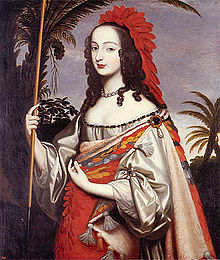Luise Hollandine from the Palatinate
Luise Hollandine von der Pfalz (born April 18, 1622 in The Hague ; † February 11, 1709 in the Cistercian convent Maubuisson ) was a princess of the Palatinate , titular Countess Palatine near the Rhine, from 1664 to 1709 abbess of the Maubuisson monastery as well as a painter and copper engraver .
Life
Luise Hollandine was a daughter of the Elector Friedrich V of the Palatinate (1596–1632) from his marriage to Elisabeth Stuart (1596–1662), daughter of King James I of England . Born after her parents' flight as the first of the children in exile in Holland, she was called Hollandine since the States General took over the sponsorship. The princess grew up in the care of educators in Leiden . After completing her training, she returned to her mother's court in The Hague. Among her applicants was the Brandenburg Elector Friedrich Wilhelm .
On December 19, 1657, she fled from Antwerp, where she was the only one of her siblings to live by her mother's side, to France to her aunt Henriette Marie , widow of the executed English king Karl I. Like her brother Eduard , she appeared in one Carmelite Convent to the Catholic faith . Combined with the escape, this led to a final break with her mother. Through the intercession of the French crown, she became abbess of the Maubuisson monastery in 1664 , in which she had entered in 1659. There she could continue to pursue painting. Nevertheless, she received a grace salary for life from the States General , and Louis XIV also offered her an annual pension of 6,000 livres. She supported her sister Sophie von Hannover in the ecclesiastical reunion efforts and was considered a patron of Jacques Bénigne Bossuet .
She developed a close relationship with her niece Elisabeth Charlotte ( Liselotte von der Pfalz ), whom she often received in Maubuisson. She had confessed to her that she u. a. had gone to the monastery in order not to have to see any more court. Elisabeth Charlotte wrote about her that Luise Hollandine was very similar to her own father, Elector Karl I. Ludwig , had his mouth, his eyes, his voice and his manners. After the death of her aunt, she noted: “ She died like a young person in the redoublement of fever. “After a stroke in 1705, Luise Hollandine was partially paralyzed for the last years of her life.
She was a talented portrait painter and was trained by Gerrit van Honthorst . Most of her works depict close relatives. It was only since the 1980s that more attention was paid to her work as an artist .
According to Andreas Räß , in The Converts since the Reformation (Volume VII, page 141), her niece Anna Henriette von Pfalz-Simmern attended the burial in Maubuisson Monastery. The funeral sermon, which also appeared in print, was given by Bishop Jacques Maboul (1650–1723) of Alet-les-Bains .
Selected Works
- Braunschweig, Duke Anton Ulrich Museum
- Double portrait of a couple as Mars and Venus. around 1669
- Hanover, Lower Saxony State Museum
- Portrait of Elisabeth, Countess of Nassau. around 1660
- Portrait of Elisabeth, Countess of Hesse Kassel. around 1670
- Portrait of Elisabeth Charlotte von Pfalz. around 1670
- Isselburg, Museum Wasserburg Anholt
- Portrait of Sophie von der Pfalz as an Indian. after 1644
literature
- Rüdiger Klessmann (editor): Herzog Anton Ulrich-Museum Braunschweig. The Dutch paintings. Herzog Anton Ulrich-Museum, Braunschweig 1983, ISBN 3-922279-01-5 .
- Marita A. Panzer: Wittelsbach women. Princely daughters of a European dynasty. Pustet, Regensburg 2012, ISBN 978-3-7917-2419-5 , pp. 84, 94-98.
- Hans Schmidt: Louise Hollandine. In: New German Biography (NDB). Volume 15, Duncker & Humblot, Berlin 1987, ISBN 3-428-00196-6 , p. 259 ( digitized version ).
Web links
- Website about Luise Hollandine von der Pfalz
- Jaques Maboul, funeral sermon (French), digital scan on google-books
Individual evidence
- ^ Mathilde Knoop: Madame Liselotte von der Pfalz , Koehler Verlag, Stuttgart, 1956, p. 76
- ^ Biographical website on Bishop Jacques Maboul
| personal data | |
|---|---|
| SURNAME | Luise Hollandine from the Palatinate |
| BRIEF DESCRIPTION | Princess of the Palatinate, abbess of the Maubuisson monastery (1664–1709) as well as painter and engraver |
| DATE OF BIRTH | April 18, 1622 |
| PLACE OF BIRTH | The hague |
| DATE OF DEATH | February 11, 1709 |
| Place of death | Maubuisson |



